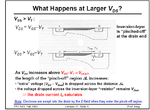asimov_18
Member level 2

- Joined
- Sep 25, 2006
- Messages
- 45
- Helped
- 2
- Reputation
- 4
- Reaction score
- 2
- Trophy points
- 1,288
- Location
- London---UK
- Activity points
- 1,816
Greetings

I have had this question about MOSFET's for a very very long time so would like to share it.
I am trying to understand how mosfets work for some application. based on the image attached.
one knows that the MOSFET works only because of the inversion layer that has the charge carriers.
If there was no inversion layer then there would be no current flow. This is precisely what happens
when the gate voltage is below threshold. So the MOSFET can be thought as behaving like a resistor
with infinite/very high resistance(practically on open circuit).
Vds =voltage drain source
Vgs = volatage gate source
Vt= threshold
for MOSFET's this is supposed to be the governing equation
if Vds > Vgs - Vt then at one end of the channel the inversion layer doesn't exist. the system is
said to be pinched off, the current is supposed to be saturated(have a constant value)
now the question is how is current flowing in absence of a channel and what is the implication of
saying that the charge carriers are swept off when they enter the pinch-off region ?
Also I was wondering what would happen if Vds was progressively increased ? Would this lead to the inversion layer
getting smaller and smaller (localized towards only the source) until it eventually ceases to exist ? How would this
described situation be any different from the one where gate voltage is less than than threshold and the device
resistance is close to infinity? And what are the implications of this on designing circuits using MOSFETs where

I have had this question about MOSFET's for a very very long time so would like to share it.
I am trying to understand how mosfets work for some application. based on the image attached.
one knows that the MOSFET works only because of the inversion layer that has the charge carriers.
If there was no inversion layer then there would be no current flow. This is precisely what happens
when the gate voltage is below threshold. So the MOSFET can be thought as behaving like a resistor
with infinite/very high resistance(practically on open circuit).
Vds =voltage drain source
Vgs = volatage gate source
Vt= threshold
for MOSFET's this is supposed to be the governing equation
if Vds > Vgs - Vt then at one end of the channel the inversion layer doesn't exist. the system is
said to be pinched off, the current is supposed to be saturated(have a constant value)
now the question is how is current flowing in absence of a channel and what is the implication of
saying that the charge carriers are swept off when they enter the pinch-off region ?
Also I was wondering what would happen if Vds was progressively increased ? Would this lead to the inversion layer
getting smaller and smaller (localized towards only the source) until it eventually ceases to exist ? How would this
described situation be any different from the one where gate voltage is less than than threshold and the device
resistance is close to infinity? And what are the implications of this on designing circuits using MOSFETs where